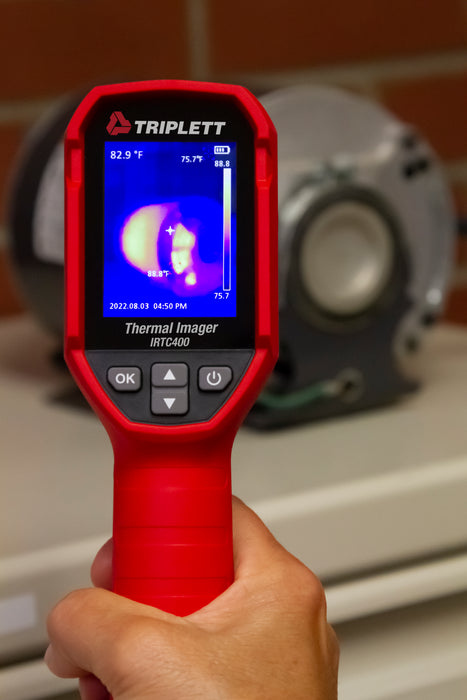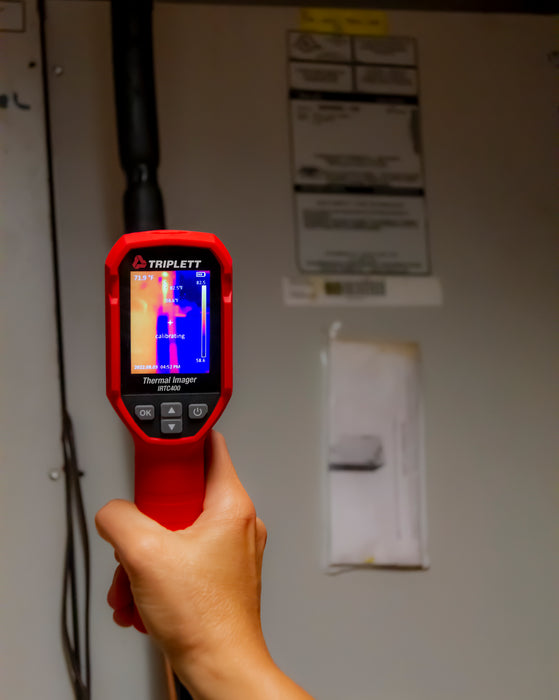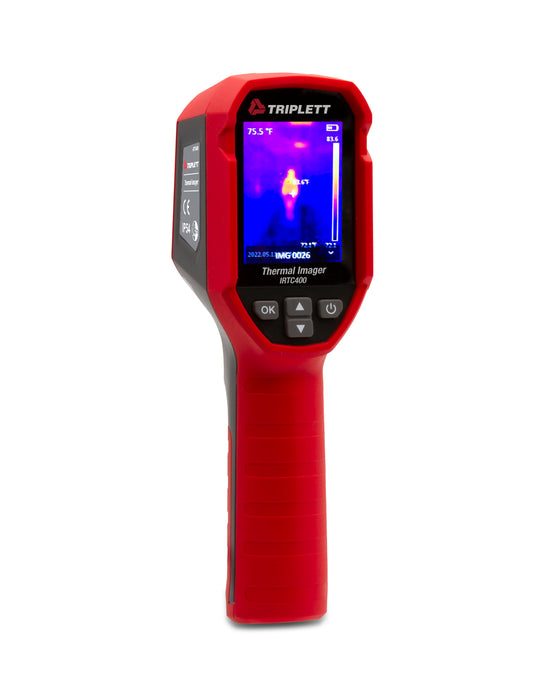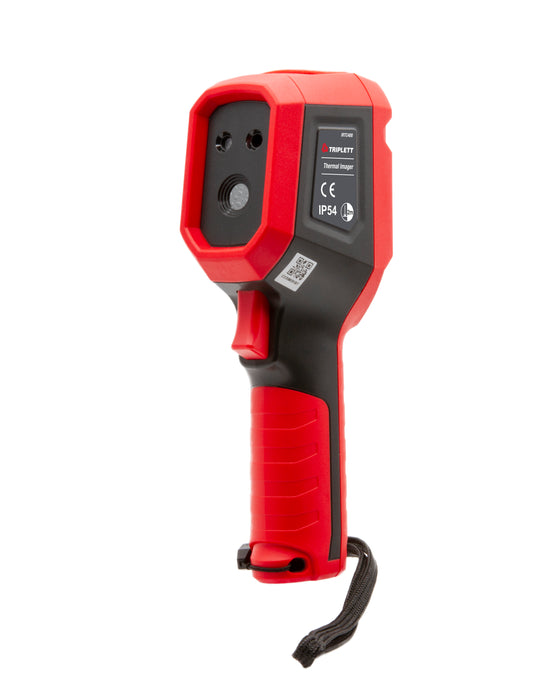Q. What is NETD?
A. NETD is an abbreviation of Noise Equivalent Temperature Difference, which indicates the ability of thermal imaging detector to detect small variation in thermal radiation in the image. Thermal imaging cameras are typically used for troubleshooting and maintenance of various devices and systems such as HVAC, electrical equipment, and so on. This is to prevent or repair leakages, moisture buildups, automotive repairs, hotspots, and so on. It is crucial that any thermal camera must be capable of measuring the minutest differences in thermal radiation in the concerned systems or devices. For this, NETD or thermal contrast is an important aspect. It is expressed in milli-Kelvin (mK). When the noise equals to the smallest measurable temperature difference, it shows the detector has achieved its fullest limit and cannot resolve a thermal signal anymore. The Triplett IRTC400 thermal imaging camera’s thermal imager has a 120 x 90 pixel (10,800) thermal detector with ≤60mk thermal sensitivity (NETD).
Q. What is the resolution and framerate of thermal imaging cameras?
A. Just like other cameras, the resolution and framerate of a thermal imaging or infrared cameras are important as well. Both these factors are important part of processing capabilities in a camera and must be considered when buying a thermal imaging camera.
Here are some pointers.
A framerate is typically the rate or speed at which images are displayed on the screen, and this largely depends on the camera frequency. Resolution implies the size of the image in pixels, and how much can it be zoomed in without compromising on clarity. Our camera has an IR resolution of 120 x 90 pixels (10,800), while the display resolution is 320 x 240 pixels. If the resolution is high, large distance images from the target point can be achieved keeping the clarity intact, without compromising on accuracy in measuring temperature differences. In infrared imaging cameras, high resolution is even more important than digital ones. This is because otherwise temperature readings occupy most of the background and the image appears small. If we zoom in it looks pixelated and hazy.
Q. Can thermal imaging detect electricity?
A. Since thermal imaging can spot temperature differences, this camera can also be used to detect electricity. They are used in identifying temperature differences in electrical circuits, and this is even applicable for 3-phase circuits in industrial units. They determine any imbalance in the circuit temperatures due to various reasons such as voltage fluctuation, issues in insulation resistance, and so on. Thermal cameras can decode the thermal signatures in case of high resistance, overheating, possibilities of shorting, and so on. Once the thermal camera captures this image, you can view it on your computer for further analysis.
Q. How far does a thermal imaging camera work?
A. The maximum distance of view, spectrum, or even capturing an image are all quite high for most thermal imaging cameras. However, what matters is the clarity and subsequently the ability to determine any possible faults, threats, and so on. While viewing an object or recognizing some presence may be easy, detection and identification are complex factors. Cameras with high resolution have more pixels which can cover the critical dimension of the target object. Here, the field of view (FOV) and minimum focus distance play a key role. Our IRTC400 camera has FOV of 50° x 38°.
Q. Can thermal imaging be used during the day?
A. While thermal imaging is specifically meant for night use in mission critical applications, it certainly works just the same in daytime. It detects heat or infrared energy in an object or surrounding, and hence is unaffected by light or darkness.
Q. How many types of sensors are available for thermal cameras?
A. While regular cameras capture light, thermal cameras capture heat in an object and form an image. So, the camera in itself acts as a heat sensor. There are several thousand sensors in this camera that detect IR heat. This data is recorded by these sensors and converted to electrical signals by which the images can be viewed on a computer or TV screen. Then, there are cooled and uncooled sensors of different resolutions.
Q. Does wind affect thermal imaging?
A. Any heat transfer happens through conduction, convection, or radiation, and heat or thermal energy is always transferred from a hot to a cold surface or object. This course of direction can, however, be changed if an external force such as wind is applied. This same principle is applicable to a thermal imaging camera as well. This is because wind can instantly change the target temperature. The same is applicable when air is blown from a fan, blower, or pump. So, when installing a thermal imaging camera especially in harsh outdoor environments, the wind factor must be considered. Often, the actual reading or the temperature is considered more than what the camera may show.
Q. How often should thermal imaging be carried out?
A. Thermal imaging cameras are used for inspections of electrical systems by many manufacturers to check for any repairs or issues that may be dangerous. These cameras sense device producing excess heat, loose connections, leakages, and similar issues in electrical systems, HVAC systems, and so on. Such surveys are carried out to ensure safety of electrical systems, equipment, property, and people. Normally, such surveys are carried out at least once in a year although the frequency may be decided based on the frequency of usage, type of systems, and other such factors.
Q. What is a thermal imaging camera?
A. A thermal imaging camera is an advanced device designed to detect and display infrared radiation emitted by objects and surfaces. It generates thermal images, also known as thermograms, which showcase temperature variations. These cameras have extensive applications, including industrial inspections, building diagnostics, firefighting, and security purposes.
Q. How does a thermal imaging camera work?
A. Thermal imaging cameras work by capturing the infrared radiation emitted by objects and converting it into a visual representation. The camera's detector measures the temperature of the radiation and assigns different colors or shades to represent various temperature levels, creating a thermal image that shows the heat distribution of the scene being observed.
Q. Are thermal imaging cameras and thermal scanners the same thing?
A. No, thermal imaging cameras and thermal scanners are different devices with distinct functionalities. Thermal imaging cameras are used for visualizing temperature variations in objects and environments, while thermal scanners are specifically designed for non-contact temperature measurement of individuals.
Q. Can thermal imaging cameras see through walls or objects?
A. Thermal imaging cameras can detect the surface temperature of objects and materials. However, they cannot see through walls or solid objects as they rely on detecting infrared radiation emitted by the surface of an object rather than penetrating it.
Q. Are thermal imaging cameras safe to use?
A. Yes, thermal imaging cameras are safe to use as they are non-invasive and do not emit any harmful radiation. They capture only the naturally emitted infrared radiation from objects and surfaces.






